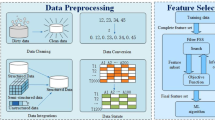Abstract
Providing anonymous communications in mobile ad hoc networks (MANETs) is an effective countermeasure against malicious traffic analysis. This paper presents AOS, an Anonymous Overlay System for MANETs, which provides provably strong source and destination anonymity under a rather strong adversary model. AOS differs significantly from previous anonymous communication systems for MANETs mainly in three aspects. First, AOS is an overlay system independent of the underlying MANET protocol stack. Second, AOS resolves the conflict between anonymous communications and secure routing in MANETs and enables providing both at the same time. Last but not least, AOS can satisfy diverse anonymity requirements with different communication and computation overhead. AOS is the first system of its kind, and its efficacy and efficiency are confirmed by detailed qualitative and quantitative analysis.





Similar content being viewed by others
Notes
If D is chosen as an onion node at multiple layers, we select l as the smallest layer.
The real onion node O i,1 is not compromised.
References
Raymond, J.-F. (2000). Traffic analysis: Protocols, attacks, design issues, and open problems. In: International workshop on design issues in anonymity and unobservability (pp. 10–29). Berkeley, CA.
Jiang, S., Vaidya, N., & Zhao, W. (2001). Prevent traffic analysis in packet radio networks. In: Proceedings of DISCEX II, Anaheim, California.
Defense Advanced Research Projects Agency (DARPA). (1998). Research challenges in high confidence networking, White paper, Arlington, VA, July 1998.
Chaum, D. (1981). Untraceable electronic mail, return addresses, and digital pseudonyms. Communications of the ACM, 24(2), 84–90.
Pfitzmann, A., & Waidner, M. (1987). Networks without user observability. Computers & Security, 6(2), 158–166.
Reiter, M., & Rubin, A. (1998). Crowds: Anonymity for web transactions. ACM TISSEC, 1(1):66–92.
Pfitzmann, A., & Hansen, M. (2005). Anonymity, unobservability, and pseudonymity: A consolidated proposal for terminology. Draft v0.25, Dec. 2005.
Kong, J., & Hong, X. (2003). ANODR: Anonymous on demand routing with untraceable routes for mobile ad-hoc networks. In: ACM MobiHoc’03 (pp. 291 – 302). Annapolis, MD.
Jiang, S., Vaidya, N. H., & Zhao, W. (2004). A mix route algorithm for mix-net in wireless mobile ad hoc networks. In: MASS’04 (pp. 406–415). Fort Lauderdale, FL.
Zhu, B., Wan, Z., Kankanhalli, M. S., Bao, F., & Deng, R. H. (2004). Anonymous secure routing in mobile ad-hoc networks. In LCN’04 (pp. 102–108). Dublin, Ireland.
Wu, X., & Bhargava, B. (2005). AO2P: Ad hoc on-demand position-based private routing protocol. 4(4), 335–348.
Zhang, Y., Liu, W., & Lou, W. (2005). Anonymous communications in mobile ad hoc networks. In IEEE INFOCOM’05 (pp. 1940–1951). Miami, FL.
Zhang, Y., Liu, W., Lou, W., & Fang, Y. (2006). MASK: Anonymous on-demand routing in mobile ad hoc networks. IEEE Transactions On Wireless Communications, 5(9), 2376–2385.
Choi, H., McDaniel, P., & La Porta, T. F. (2007). Privacy preserving communication in MANETs. In IEEE SECON’07 (pp. 233–242). San Diego, CA.
Aad, I., Castelluccia, C., & Hubaux, J.-P. (2006). Packet coding for strong anonymity in ad hoc networks. In SecureComm’06, Baltimore, MD.
Chou, C.-C., Wei, D. S., Kuo, C.-C. J., & Naik, K. (2007). An efficient anonymous communication protocol for peer-to-peer applications over mobile ad-hoc networks. IEEE Journal on Selected Areas in Communications, 25(1), 192–203.
Dong, Y., Chim, T. W., Li, V. O., Yiu, S., & Hui, C. (2009). ARMR: Anonymous routing protocol with multiple routes for communications in mobile ad hoc networks. Ad Hoc Networks, 7(8), 1536–1550.
El Defrawy, K., & Tsudik, G. (2007). ALARM: Anonymous location-aided routing in suspicious MANETs. In: ICNP’07 (pp. 304–313). Beijing, China.
Kao, J.-C., & Marculescu, R. (2007). Real-time anonymous routing for mobile ad hoc networks. In WCNC’07 (pp. 4139–4144). Hongkong, China.
El Defrawy, K., & Tsudik, G. (2008). PRISM: Privacy-friendly routing in suspicious MANETs (and VANETs). In ICNP’08 (pp. 258–267). Orlando, FL.
Wu, X., Liu, J., Hong, X., & Bertino, E. (2008). Anonymous geo-forwarding in MANETs through location cloaking. IEEE Transactions on Parallel and Distributed Systems, 19(10), 1297–1309.
Hu, Y.-C., Perrig, A., & Johnson, D. B. (1986). Packet leashes: A defense against wormhole attacks in wireless ad hoc networks. In IEEE INFOCOM’03 (pp. 1976–1986). San Francisco, CA.
Hu, Y.-C., Perrig, A., & Johnson, D. B. (2003). Rushing attacks and defense in wireless ad hoc network routing protocols. In WiSe’03 (pp. 30–40). San Diego, CA.
Hu, Y.-C., Perrig, A., & Johnson, D. B. (2002). Ariadne: A secure on-demand routing protocol for ad hoc networks. In: ACM MobiCom’02 (pp. 12–23). Atlanta, GA.
Hu, Y.-C., Johnson, D. B., & Perrig, A. (2003). SEAD: Secure efficient distance vector routing for mobile wireless ad hoc networks. Ad Hoc Networks, 1(1), 175–192.
Sanzgiri, K., LaFlamme, D., Dahill, B., Levine, B., Shields, C., & Belding-Royer, E. (2005). Authenticated routing for ad hoc networks. IEEE Journal on Selected Areas in Communications, 23(3), 598–610.
Reed, M., Syverson, P., & Goldschlag, D. (1998). Anonymous connections and onion routing. IEEE Journal on Selected Areas in Communications, 16(4), 482–494.
Camenisch J., & Lysyanskaya, A. (2005). A formal treatment of onion routing. In: Advances in Cryptology—CRYPTO 2005 (pp. 169–187). Santa Barbara, California, USA.
Zhang, Y., Lou, W., & Fang, Y. (2007). A secure incentive protocol for mobile ad hoc networks. Wireless Networks, 13(5): 569–582.
Zhang, Y., Liu, W., Lou, W., & Fang, Y. (2006). Securing mobile ad hoc networks with certificateless public keys. IEEE Transactions on Dependable and Secure Computing, 3(4), 386–399
Boneh, D., & Franklin, M. (2001). Identity-based encryption from the weil pairing. In: CRYPTO’01, Santa Barbara (pp. 213–229). CA.
Barreto, P., Kim, H., Bynn, B., & Scott, M. (2002). Efficient algorithms for pairing-based cryptosystems. In CRYPTO’02 (pp. 354–368). Santa Barbara, CA.
Kate, A., Zaverucha, G., & Goldberg, I. (2007). Pairing-based onion routing. In PETS’07, Ottawa, Canada.
Wright, M. K., Adler, M., Levine, B. N., & Shields, C. (2004). The predecessor attack: An analysis of a threat to anonymous communications systems. ACM Transactions on Information and System Security, 7(4), 489–522.
Danezis, G., Diaz, C., Kasper, E., & Troncoso, C. (2009). The wisdom of Crowds: Attacks and optimal constructions. In ESORICS’09, St Malo, France.
Scott, M. (2005). Computing the tate pairing. In CT-RSA’05 (pp. 293–304). San Francisco, CA.
Serjantov, A., & Danezis, G. (2002). Towards an information theoretic metric for anonymity. In PET’02, ser. LNCS vol. 2482, (pp. 41–53). Berlin: Springer.
Cover, T. M., & Thomas, J. A. (2006). Elements of information theory (2nd edn.). London: Wiley.
Díaz C., Seys, S., Claessens, J., & Preneel, B. (2002). Towards measuring anonymity. In: PET’02, ser. LNCS, vol. 2482. (pp. 54–68). Berlin: Springer.
Acknowledgments
The work of Y. Zhang was partially supported by the US National Science Foundation under grants CNS-0716302 and CNS-0844972. The work of Y. Fang was partially supported by the US National Science Foundation under grant CNS-0716450, the National Natural Science Foundation of China under grant 61003300, and China 111 Project under grant B08038.
Author information
Authors and Affiliations
Corresponding author
Rights and permissions
About this article
Cite this article
Zhang, R., Zhang, Y. & Fang, Y. AOS: an anonymous overlay system for mobile ad hoc networks. Wireless Netw 17, 843–859 (2011). https://doi.org/10.1007/s11276-010-0319-2
Published:
Issue Date:
DOI: https://doi.org/10.1007/s11276-010-0319-2




